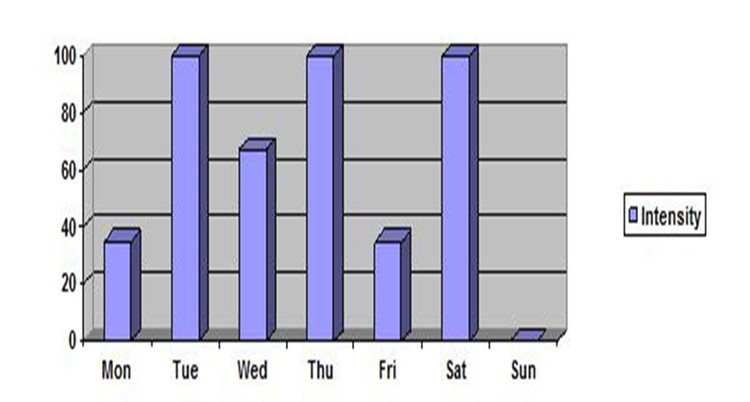Undulating Periodisation
The undulating model involves a greater variation in volume and intensity within a microcycle or from week to week. The original rationale being that short periods of training emphasising hypertrophy alternated with short periods of training emphasising maximal strength, would provide a better alternative to the linear approach. The coach could adjust the focus of the training on a weekly basis. So rather than the linear approach of developing hypertrophy then maximal strength, the trainer could have week 1 as hypertrophy focused and week 2 as strength focused and adjust as they go on. Undulating periodisation can also be thought of in the context of training load. Weeks can be adjusted from high, intermediate to low training loads to try and achieve the desired adaptations. This method has the advantage of providing alternating stresses which could enhance recovery and allow for adaptation to occur.
The daily undulating periodised (DUP) model is a variation of the undulating model. The key difference being that alterations of training volume and intensity are made daily as opposed to a weekly basis. These alterations can target a range of physical capacities in a single week such as hypertrophy and strength. A type of daily undulating periodisation that is common is the “high low” training concept in which high training load days are broken up with lower load training days. The body is not designed to work at 100% all the time and so by alternating high and low intensity training sessions, the body should have time to recover and adapt. It is an approach commonly used in rugby. The very high training load session would not be ideal the day before a game. Typically, the high load is done earlier in the week and the low load is done leading up to the game, so the players are feeling fresh and ready to play on match day. Figure 3. below shows what a daily undulating microcycle may look like. It has high, intermediate, and low training load days.
Figure 3. Daily undulating periodisation
 Research comparing undulating periodisation to linear periodisation has generally been equivocal with some studies favouring undulating periodisation, some favouring linear and some finding no significant differences between the two models. For example, Williams and colleagues in 2017 found an advantage for undulating periodisation over linear periodisation in maximal strength gains, however, very few studies met their inclusion criteria for this analysis. In a more detailed analysis of linear versus undulating periodisation, Harries and colleagues in 2015 found both models of periodisation lead to improvements in muscular strength for the upper and lower body, but no clear evidence favouring either approach was clear.
Research comparing undulating periodisation to linear periodisation has generally been equivocal with some studies favouring undulating periodisation, some favouring linear and some finding no significant differences between the two models. For example, Williams and colleagues in 2017 found an advantage for undulating periodisation over linear periodisation in maximal strength gains, however, very few studies met their inclusion criteria for this analysis. In a more detailed analysis of linear versus undulating periodisation, Harries and colleagues in 2015 found both models of periodisation lead to improvements in muscular strength for the upper and lower body, but no clear evidence favouring either approach was clear.